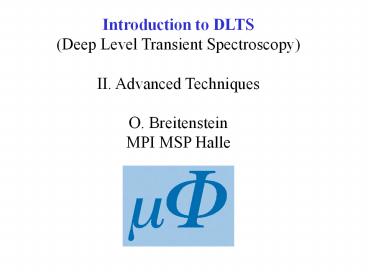Introduction to DLTS - PowerPoint PPT Presentation
1 / 14
Title:
Introduction to DLTS
Description:
Recapitulation: DLTS routine (repeating!) : t. Vr. e- e- e- e- e- t. DC. t. 0. 0. bias. band ... If T is slowly varying, at a certain temperature a DLTS peak ... – PowerPoint PPT presentation
Number of Views:144
Avg rating:3.0/5.0
Title: Introduction to DLTS
1
Introduction to DLTS (Deep Level Transient
Spectroscopy) II. Advanced Techniques O.
Breitenstein MPI MSP Halle
2
- Outline
- 1. Basic principles
- Application field of DLTS
- Principles of DLTS
- Basic measurement techniques
- 2. Advanced techniques
- Advanced DLTS measurement techniques
- 3. (next time) Our DLTS system
- - Philosophy
- - Hardware
- - User surface
3
Recapitulation DLTS routine (repeating!)
reverse
reduced or forward
reverse
Vr
bias
t
0
e-
e-
e-
band diagram
e-
e-
RF- capacitance
t
DC
0
t
4
Generation of the DLTS signal
opt. T
low T
high T
"rate window"
If T is slowly varying, at a certain temperature
a DLTS peak occures
5
DLTS measurements at different rate windows allow
one to measure Et
This "Arrhenius plot" allows an identification of
a deep level defect
6
2. Advanced DLTS measurement techniques 2.1.
Possible samples Schottky diodes or pn-junctions
Schottky diode
pn-junction
reverse bias
V 0
xe
forward bias
minority carrier injection
majority carrier flow
7
- Schottky diodes
- Standard, easy to prepare, high quality demand !
- Only majority carrier traps visible, even under
forward bias - pn-junctions
- reverse bias reduction up to 0V "majority
carrier pulse" - forward bias (injection) "minority carrier
pulse" (MC) - MC pulse may reveal both minority and majority
carrier traps - However, if opposite carrier capture dominates,
traps may remain uncharged (invisible in DLTS)
gt basic limitation ! - Asymmetric doping concentration signal from
lower doped side - Other sample types
- Grain boundary (anti-serial Schottky diodes) gt
bonded wafers - MIS devices
- FETs ("conductivity DLTS")
- point contacts at nanowires ? ...
8
- 2.2. Optically excited DLTS (minority carrier
DLTS, MCDLTS) - trap filling by optically excited minority
carriers (hn gt Eg) - reverse bias remains constant
thermal equilibrium traps emptied (from holes)
measurement hole emission
filling pulse hole capture
- allows investigation of minority carrier traps
in Schottky diodes
9
- 2.3. Optical DLTS (ODLTS)
- trap filling by bias pulses
- continuous irradiation of IR light (lt Eg)
- optical emission additional to thermal emission
- strong dependence on intensity and l
illuminated
dark
- ODLTS allows to measure optical capture cross
sections sopt(l) - connection between deep levels electrically
detected (DLTS) and optically detected
(absorption)
10
2.4. Concentration depth profiling (pulse height
scan)
Vr
t
Vr
t
Vr
t
Vr
t
- linear dependence on Vp homogeneous
concentration !
11
2.5. Measurement of field dependence of enp
(pulse height scan)
Vr
t
Vr
- quantitative evaluation difference spectra
(DDLTS) - field depencence indicates charged occupied state
t
Vr
t
Vr
t
12
2.6. Measurement of capture cross sections (pulse
width scan)
Vr
t
Vr
t
Vr
- "real" capture cross section
- measurement at different rate windows
T-dependence of CCS - injection measurement of minority carrier CCS
t
Vr
t
13
2.7. Point defects and extended defects
- all previous considerations referred to isolated
point defects - "extended defects" dislocations, grain
boundaries, precipitates ... - continuum of states, "broadened states"
- emission probability depends on average
occupation state - barrier-controlled capture, depending on
occupation state
point defect
extended defect
DLTS
low occupation
T
DLTS
high occupation
tc
log(timp)
- extended defects show logarithmic capture
behaviour
14
- Summary
- DLTS on Schottky diodes only reveals majority
carrier taps - DLTS on pn junctions also reveals minority
carrier traps - Optically excited DLRS (MCDLTS) also reveals
minority carrier traps in Schottky diodes - ODLTS reveals optical trap parameters sopt(l)
- There are special DLTS procedures for measuring
- - concentration depth profiles
- - electric field dependence of enp
- - capture cross sections for electrons and holes
- Extended defects are usually characterized by a
logarithmic capture behaviour and often show
non-exponential emission (broadened peaks) - Next time Introduction of our own DLTS system































